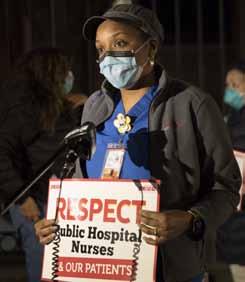Sounding the Alarm In January, even before the first confirmed case in the U.S., NYSNA began preparing for COVID-19, sounding the alarm to our employers and the New York State Department of Health. Despite the many unknowns, NYSNA’s earliest recommendations for personal protective equipment (PPE) have become standard practice for protecting healthcare workers from COVID-19, including the use of N95 respirators, face shields, gloves and impermeable gowns.
Airborne Precautions and Better PPE From the beginning, NYSNA’s health and safety experts also stressed the need for airborne precautions, and pushed for better administrative and engineering controls in our hospitals to protect both patients and healthcare workers. By February, NYSNA members were turning this critical information into action—pressing for better patient screening and cohorting procedures, requesting information on PPE stockpiles, and advocating for improved ventilation and the use of negative pressure rooms to stop the spread of the virus. Unfortunately, federal foot dragging, coupled with delays at the state and local level, left New York unprepared for COVID’s springtime surge. On March 1, New York identified its first COVID-19 patient and by March 7, the Governor had issued a state of emergency. Despite case counts doubling every day, and the containment zone established around early COVID-19 hotspot New Rochelle on March 10, lawmakers continued to resist aggressive suppression measures and sent mixed messages to the public. Alarmed by the slow response, NYSNA held a press conference on March 11, to share the reality of what was unfolding in hospitals around New York. Results from our early-March survey 6
2020 a year like no other
NYSNA Executive Director Pat Kane, RN, sounds the alarm about the slow state and federal response to the COVID threat.
demonstrated just how unprepared we were for COVID-19, and NYSNA leaders warned that the relaxed infection control protocols recently issued by Centers for Disease Control would put more healthcare workers at risk.
A CALL TO PROTECT NURSES AND PATIENTS Within a week we were also calling on state officials to reverse relaxed quarantine standards from the New York Department of Health and implement testing protocols for healthcare workers exposed to COVID-19. We also urged the Governor to coordinate PPE procurement and distribution across the state and to impose a moratorium on hospital closures and healthcare budget cuts. Despite our calls for more staff, for better PPE, for stronger infection control standards from the CDC and the New York Department of Health, as well as more aggressive measures to suppress the virus, it wasn’t until March 20 that the Governor issued the state-at-home order. Three days later New York City reported 35% of all COVID-19 cases in the U.S. and Governor Cuomo ordered hospitals to expand bed capacity by 50 percent. By the end of March more than 1,500 New Yorkers had been killed by COVID-19.














